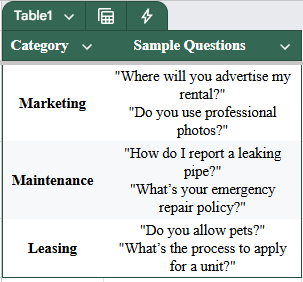
In today’s digital world, property management companies need to do more than just respond to inquiries—they need to do it fast, accurately, and 24/7. That’s where a chatbot comes in.
Installing a chatbot on your website and training it to answer questions specific to your marketing, maintenance, and leasing operations can free up your team’s time and impress prospects and tenants alike.
This guide breaks the process down step by step—no technical background needed.
Step 1: Pick the Right Chatbot Platform
The right tool makes all the difference. You’ll want a platform that supports custom training, integrates easily with your website, and is smart enough to handle different types of questions.
Popular Options:
Tidio – Great for WordPress; combines live chat and AI.
Chatbase / CustomGPT.ai – Upload your own docs to create a truly trained chatbot.
Dialogflow (Google) – For more complex bots and AI customization.
Botpress – Open-source and developer-friendly.
ManyChat / Landbot – Ideal for decision-tree style chat flows.
Step 2: Add the Chatbot to Your Website
If You Use WordPress:
Choose a chatbot plugin like Tidio.
Install and activate it through your dashboard.
Customize it using the plugin settings.
If You Have a Custom HTML Site:
Copy the JavaScript snippet provided by your chatbot provider.
Paste it just before the </body> tag in your website’s HTML code.
That’s it—your chatbot is now live on your website!
Step 3: Feed the Bot Your Company’s Knowledge
This is where the real power kicks in.
Organize Your Information into 3 Key Buckets:
Marketing – Where you post listings, how you attract tenants, turnaround time.
Maintenance – How tenants report issues, emergency protocol, repair timelines.
Leasing – Rental requirements, lease signing process, rent payment setup.
File Formats That Work:
Google Docs
PDFs
Web page links
Word Documents
Spreadsheets (FAQs, processes)
Upload these into the chatbot’s backend—most platforms like Chatbase let you do this in a few clicks.
Step 4: Train the Bot to Answer Like a Pro
On AI Platforms (e.g., Chatbase, CustomGPT):
Upload your files.
Write a few sample Q&A interactions to fine-tune its tone and accuracy.
Set rules for how it should respond (e.g., professional and friendly).
On Flow-Based Platforms (e.g., Dialogflow or Landbot):
Create “intents” like “how to renew lease” or “how to request maintenance”.
Add sample phrases people might say.
Provide the exact answers or actions the bot should take.
Make sure to test how the bot performs with real questions.
Step 5: Test, Monitor, and Improve
Now that your bot is answering questions, you’ll want to make it smarter over time.
Track what questions it fails to answer.
Add more documents or refine its responses.
Update the knowledge base when your processes change.
Some platforms also offer analytics, so you can see which topics are most popular.
Step 6: Set Up Handoffs to Human Agents
Not every question should be automated. You can configure the bot to:
Collect contact details when unsure.
Escalate to a live team member during business hours.
Tag conversations as “Maintenance,” “Marketing,” or “Leasing” for quick reference.
This hybrid approach delivers speed and personalized service.
Bonus: Integrate With Your PM Tools
Many chatbot platforms allow integrations via Zapier or native connectors. If your PM company uses tools like:
AppFolio
Buildium
Rent Manager
…you can trigger workflows like:
Creating a maintenance ticket.
Sending leasing documents.
Adding leads to your CRM.
This takes your bot from just answering questions to actually handling tasks.
Example Chatbot Questions It Should Handle

Train your chatbot on these examples, and it’ll become your virtual team member—always ready to help.
Final Thoughts
Adding a chatbot to your property management website is one of the best decisions you can make this year.
It gives your team breathing room, improves tenant experience, and turns curious website visitors into engaged leads—all on autopilot.
Start small, train intentionally, and build over time. Before long, your bot will be answering questions better than your office phone ever could.
